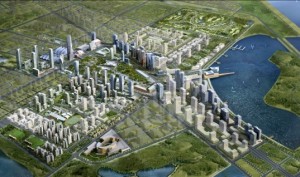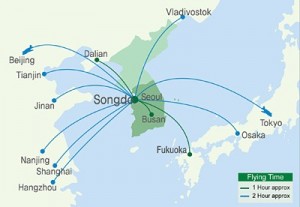By Doris Byeon

“Songdo IBD: South Korea’s New Eco-City | Inhabitat – Sustainable Design Innovation, Eco Architecture, Green Building.” Inhabitat Sustainable Design Innovation Eco Architecture Green Building Songdo IBD South Koreas New EcoCity Comments. Inhabitat, Web. 16 Dec. 2013.
Songdo International City
The South Korean government envisioned South Korea as a Northeast Asia business hub of knowledge and service-oriented economy with high technology. The Korean Ministry of Finance and Economy, in 2002, published a document to form South Korea as the “Northeast Asia’s Business Hub”. The government legislated the creation of Free Economic Zones in cities besides the central Seoul. This implied that whereas the capital Seoul would continue to be the country’s main economic and knowledge center, new growth would contribute to fulfill this vision. The cities around the ports became spots for development. The Incheon Free Economic Zone (IFEZ) sought to create special cities as international hub for logistics, business, leisure and new high-tech clusters. The IFEZ has been developed through new cities, including the Songdo.
Songdo District is located in Incheon, where the new international airport is located; as Inchoen grew as a manufacturing hub and attracted population, it transformed into the industrial extension of the capital Seoul with concentrated services and functions. The city is in a convenient location within the Korean peninsula near the capital Seoul and East Asia.
The Songdo District’s development reflects the country’s willingness to draw more global-scale business and to activate the distinct growth engines within the capital region and Seoul. The Songdo district sought to become an international business hub and knowledge location by 2020 with 250,000 new inhabitants, in 50 square km. Songdo has already gained a worldwide attention; Songdo’s development has been promising with the strong involvement of private foreign capital.
The initial plan for Songdo as the “Smart City” was more focused on housing. However, over time, the aim changed into highly technological and international characteristics of the city. Over time, the focus transformed into a “functionally combined business and knowledge location.” More involvement of foreign actors rapidly changed the direction of the development process. As the actors’ roles changed over time, their power and influence also did. For example, increased power and influence of foreign investment and capital shaped the Songdo development as well.
Changes in Aim: From Housing Decentralization to Economic Decentralization
The aim for Songdo and the IFEZ explicitly was set to create a “wonder place” with beautiful lifestyle. Songdo attempts to provide high quality living, office, and housing alternatives to the congested and expensive Seoul in response to the demands for quality housing and business space. These goals have been created in efforts to draw more population to the satellite city.

Korea Is Building The City Of The Future On An Artificial Island.” Business Insider. Web. 16 Dec. 2013.
So what are the reasons behind the weakened goal/aim on public housing?
It is notable that the Songdo’s proximity to the capital Seoul have been both pros and cons. At a first glance, Songdo seems to have more advantages since it could draw more population and development from Seoul. In fact, Incheon has been geopolitically and economically important largely because of its port and proximity to Seoul. However, at the same time, it has experienced challenges of claiming functional independence and diversifying its economy (given the fact that Seoul is dominating most of the activities). Songdo’s aim for public housing has become more broad and vague as an attempt to overcome this challenge by focusing more on its economic decentralization.
Furthermore, Songdo’s goal for housing has transformed along with the fundamental changes South Korea has experienced. Firstly, the government started to focus more on the economic liberalization (for the vision of international hub) and the high-technology development. Furthermore, South Korea, along with the housing decentralization, enforced the economic decentralization policy on metropolitan cities. As a result, the housing decentralization transformed into the economic decentralization.
Such transformation in its focus contributed to the failure of the Songdo city. As the development focused more on establishing high-tech facilities for businesses and educational institutions, Songdo’s residential zone became mainly for the exclusive groups of higher-income classes, foreigners, or elites. The average house price became higher than that of Incheon. International institutions and facilities have been targeted for the upper/elite classes instead of the original intent of drawing variety of population away from the capital. For example, Chadwick International School (pre-school to high school)’s tuition is $30,640, which cannot be afforded by people with average income. Therefore, middle/lower income classes have no incentive to live there in expensive housing with no jobs offered. As the business/residential areas are predominated by the high income class, lower income class has only been drawn away from the city. Despites its great quality with high technology and international business centers, Songdo fails to draw more variety of population and address social equity in planning.
In conclusion, in an attempt to distinguish as a suburbanized satellite city by developing more international characteristics of the Songdo, it lost its original aim of public housing for larger population. The ambition to become a place for “activities of the knowledge economy” with clusters of high-technology has only weakened the public housing aspect of the city. The real needs of the housing for the residents and the people’s voices were largely ignored.
Part II: Songdo II: Positive Aspects of the Brand New City
References
Kidney, Grant J. “World’s First ‘Smart City’ To Be Completed By 2015: ‘Songdo’ The Orwellian Control Grid.” 29 July 2012. Infowars.com. Web. 23 Oct. 2013.
Kim, Joon H. “Korean Environmental Regulations: Ready to Take on One of the World’s Largest Private Real Estate Development Projects?” Pacific Rim Law & Policy Journal 1 June 2006: 2. Print. (Peer-reviewed)
Shwayri, Sofia T. “A Model Korean Ubiquitous Eco-City? The Politics of Making Songdo.” Journal of Urban Technology 20.1 (2013): 39-55. Print. (Peer-reviewed)
Winden, Willem van. Creating Knowledge Locations in Cities: Innovation and Integration Challenges. London, NY: Routledge, 2012. Print.
